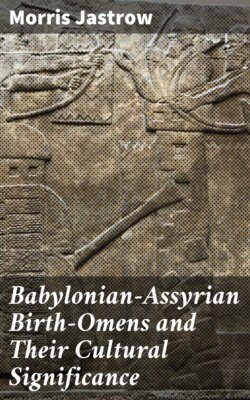Читать книгу Babylonian-Assyrian Birth-Omens and Their Cultural Significance - Morris Jastrow - Страница 4
На сайте Литреса книга снята с продажи.
II
ОглавлениеTable of Contents
The observation of signs observed in young animals and in infants at the time of birth constitutes a third division of Babylonian-Assyrian divination, quite equal in prominence to Hepatoscopy and Astrology. Here too we are justified in seeking for some rational or quasi-rational basis for the importance attached by Babylonians and Assyrians, and as we shall see by other nations as well, to anything of a noteworthy or unusual character observed at the moment that a new life was ushered into the world. The mystery of life made as deep an impression upon primitive man and upon ancient peoples as it does on the modern scientist, who endeavors with his better equipment and enriched by the large experience of past ages, to penetrate to the very source of life. A new life issuing from another life—what could be stranger, what more puzzling, what more awe-inspiring? If we bear in mind that there is sufficient evidence to warrant us in saying that among peoples in a primitive state of culture, the new life was not associated with the sexual act[10], the mystery must have appeared still more profound. The child or the young animal was supposed to be due to the action of some spirit or demon that had found its way into the mother, just as death was supposed to be due to some malicious demon that had driven the spirit of life out of the body. The many birth customs found in all parts of the world[11], are associated with this impression of mystery made by the new life; they centre largely round the idea of protection to the mother and her offspring at a critical period. The rejoicing is tempered by the fear of the demons who were supposed to be lurking near to do mischief to the new life and to the one who brought it forth. The thought is a natural one, for the young life hangs in the balance, while that of the mother appears to be positively threatened. All bodily suffering and all physical ailments being ascribed to the influence of bad demons, or to the equally malevolent influence of persons who could by their control of the demons or in some other way throw a spell over the individual, Birth, Puberty, Marriage and Death as the four periods in life which may be regarded as critical and transitional are marked by popular customs and religious rites that follow mankind from primitive times down to our own days. A modern scholar, Van Gennep, who has recently gathered these customs in a volume and interpreted them, calls his work ‘Rites de Passage’, i. e., customs associated with the four periods of transition from one stage to the other and which survive in advanced forms of faith as Baptism, Confirmation, Marriage ceremonies and Funeral rites, just as the chief festivals in all religions are the ‘Rites de Passage’ of nature—associated with the transition periods of the year, with the vernal equinox, the summer solstice, the autumnal equinox and the winter solstice or, expressed in agricultural terms, with sowing time, with blossoming or early harvest time, with the later harvest time and with the period of decay.
The significance attached to birth omens is thus merely a phase of the ceremonies attendant upon the passage of the new-born from its mysterious hiding place to the light. The analogy between the new life and the processes of nature is complete, for the plant, too, after being hidden in the earth, which is pictured in the religions of antiquity as a ‘great mother’, comes to the surface.
